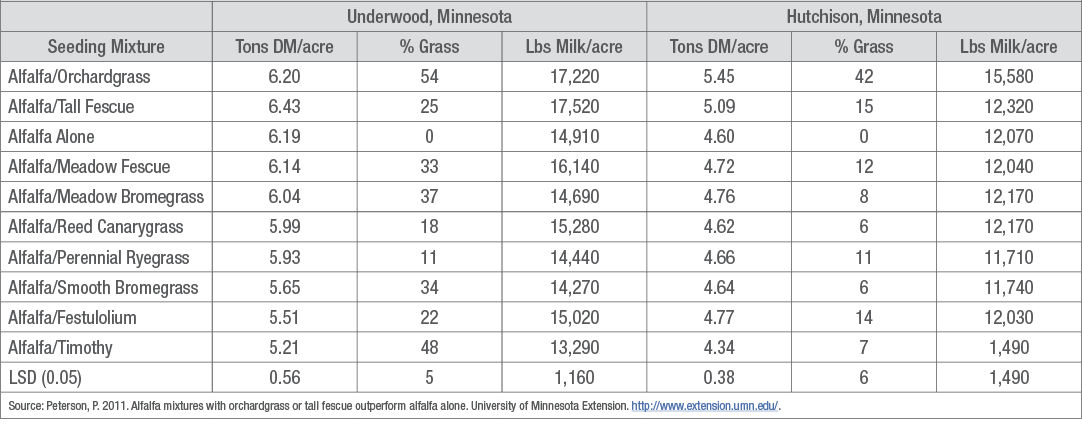5 MIN READ
Productivity of Alfalfa Grass Mix Versus Alfalfa Alone
February 2, 2021
Alfalfa mixed with 30 to 40% grass may have the potential to achieve equal or higher yields and feeding quality compared to pure alfalfa stands.
Alfalfa-only fields continue to dominate forage production throughout the Midwestern states; however, alfalfa/grass fields are a common practice in the Northeastern United States dairy region. There are agronomic and livestock nutrition advantages to establishing alfalfa-grass mixes versus alfalfa-only stands.
Advantages of Alfalfa-Grass Seeding Mix Yield.
A key benefit for seeding an alfalfa/grass mix is the potential to achieve equal or higher yields when the final stand is comprised of 30 to 40% grass(es) compared to a pure stand of alfalfa.1 A small grain or annual ryegrass companion crop seeded with a spring alfalfa/grass mix may have a higher yield potential in the seeding year compared to direct-seeded alfalfa only.
A University of Minnesota study indicated in the second year of production at one location (Underwood); orchardgrass or tall fescue mixtures with alfalfa had approximately 15% more milk production potential per acre compared to alfalfa alone (Table 1).2 However, the total season dry matter yields were similar for the alfalfa/grass mixes and the pure alfalfa stand (Table 1). Another location (Hutchison) indicated alfalfa mixed with orchardgrass had about 28% more milk production potential per acre compared to alfalfa/tall fescue mix or pure alfalfa. Additionally, at this location, alfalfa mixed with orchargrass or tall fescue had about 10 to 18% more total dry matter yield compared to pure alfalfa stands. Overall, the research study demonstrates the potential for alfalfa/grass mixes to equal or exceed the performance of pure alfalfa stands; however, there has been considerable variation across locations especially the percentage of emerged grass species with alfalfa.

Feeding Value. Generally at similar stages of maturity, grasses have higher neutral detergent fiber (NDF) levels than alfalfa and have considerably higher NDF digestibility.3 As NDF percent increases, ruminant livestock’s dry matter intake generally decreases. Relative feed value (RFV) has been used as an index for determining alfalfa nutritional quality, but it tends to underestimate the feeding value of grasses and its higher NDF digestibility. Relative forage quality (RFQ) index provides a more accurate indication of grasses’ higher fiber digestibility and it’s impact on energy and intake potential. Dairymen may feed straw in order to add fiber to their rations; however, forage grasses can provide that fiber in a more digestible form.
Other Considerations. Grasses added at a 30% level with alfalfa can shorten swath drying time compared to pure alfalfa. However, leafy grasses with shiny surfaces, such as tall fescue and ryegrasses, added to alfalfa may not shorten drying time. Alfalfa/grass mixtures can improve overall stand persistence. Fall growth of grasses can provide better snow catch and insulation compared to alfalfa stubble alone; therefore, alfalfa crowns have improved protection from winter injury. Also, if winter-hardy grasses are mixed with alfalfa they can provide insurance if alfalfa does winter-kill. When used for grazing, alfalfa/grass mixes have less potential for bloat compared to alfalfa-only fields. Also, alfalfa/grass mixtures may provide improved erosion control compared to pure alfalfa stands.
Selecting a Grass Species and Variety
Deciding which grass specie(s) to mix with alfalfa is important; however, selecting a variety within a grass species may have more impact on overall stand productivity. Characteristics to consider when selecting a grass variety include the following:
- Select high yielding varieties. Grass variety trial results may be available from your state University Extension Service.
- Consider medium- to late-maturity grass varieties that match your alfalfa variety maturity. Early-season grass varieties may head out before the alfalfa is ready for harvest. Also, some varieties head out two weeks later than others.
- Select varieties that are winter-hardy for your area. Orchardgrass varieties vary in their winter-hardiness.
- Consider varieties that have a more consistent yield throughout the season.
- Select orchardgrass, tall fescue, and meadow fescue varieties that contain disease resistance to rust.
Management Considerations When Seeding
As stated previously, when seeding an alfalfa/grass mix the goal should be acheiving a stand comprised of 30 to 40% grasses. The focus should be planting seeds per square foot vs. pounds per acre. Seeding rate recommendations are generally accepted as 60 to 75 seeds per square foot resulting in a final stand at the end of the first year of 30 to 35 plants in the same area to maximize yield potential.4 A rule of thumb is seeding alfalfa at 10 pounds per acre, which is about 47 seeds per square foot with the remainder being grasses. Field observations indicate that adding a low rate of annual ryegrass at seeding will significantly add to first cut yield while providing additional early weed competition and soil erosion control.Various planting methods and techniques are available to establish a sucessful alfalfa/grass mix. Some establishment failures are generally the result of poor seed/soil contact, seed placed too deep, or soil pH problems not compatible to the mix created. Before seeding, determine that seedbed conditions are optimal including soil moisture, firmness, and residue management. Regardless of seeding method or equipment used, check often to help ensure your method is delivering the correct amount of seed uniformly at a target depth of 1/4 inch.
Sources
1Undersander, D. Alfalfa grass mixtures in dairy rations. University of Wisconsin Extension. http://www.uwex.edu/.
2Peterson, P. 2011. Alfalfa mixtures with orchardgrass or tall fescue outperform alfalfa alone. University of Minneso-taExtension. http://www.extension.umn.edu.
3Peterson, P. Seeding grasses with alfalfa. University of Minnesota Extension. https://extension.umn.edu/pasture-based-dairy/seeding-grasses-alfalfa.
4Holen, D. 2018. Establishing alfalfa-grass mixtures. University of Minnesota Extension. https://extension.umn.edu/planting-forages/establishing-alfalfa-grass-mixtures#:~:text=Maximize%20the%20mixture%20by%20aiming,75%20seeds%20per%20square%20foot.
5Undersander, D. Selecting a good grass variety. University of Wisconsin Extension. http://www.uwex.edu/.
Web sources verified 01/25/21. 1028_S3